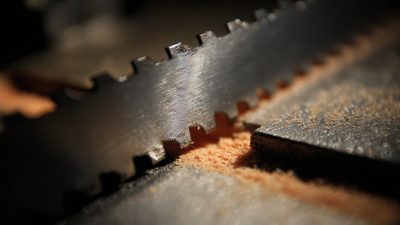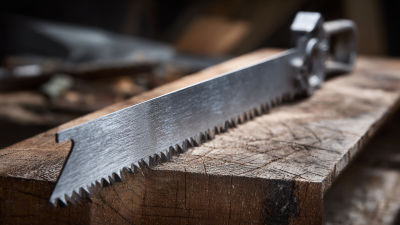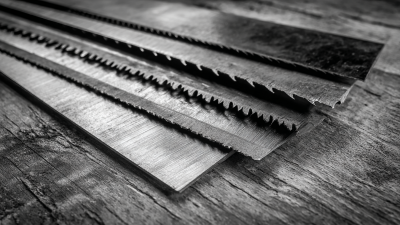What is the Importance of Using a Hacksaw Blade for Steel in Metal Fabrication
Table of Contents
- Importance of Hacksaw Blades in Steel Fabrication for Precision Cuts
- Understanding the Material Composition of Hacksaw Blades for Enhanced Durability
- Comparative Analysis: Hacksaw Blades vs. Other Cutting Tools in Metal Fabrication
- Industry Data: The Average Lifespan and Efficiency of Steel Hacksaw Blades
- Best Practices for Choosing the Right Hacksaw Blade for Steel Projects
- Safety Protocols When Using Hacksaw Blades in Metal Fabrication Settings
- Maximizing Efficiency in Metalworking: The Advantages of T344D Saw Blade for High Carbon Steel Cutting
- FAQS
- Conclusion
- Related Posts
You know, when it comes to metal fabrication, using a good hacksaw blade for steel isn’t just a nice-to-have—it’s pretty much essential. Especially these days, with the industry really picking up speed. I recently read that the global market for metal fabrication was worth over $18 billion back in 2021, and it’s expected to keep growing at about 3.4% each year through 2030. That just goes to show how important it is for both pros and DIY folks to use reliable tools. Speaking of which, Wenzhou Yichuan Tools Co., Ltd.—they’ve been around since 2003 and really focus on making top-notch electric tool accessories, including these fantastic hacksaw blades made specifically for cutting steel smoothly and efficiently. Choosing the right blade not only makes your cuts better and safer but also helps you stay precise. In the end, having good tools really makes all the difference in hitting industry standards and satisfying your clients or just getting the job done right at home.

Importance of Hacksaw Blades in Steel Fabrication for Precision Cuts
Hacksaw blades might not be the first thing that comes to mind, but honestly, they’re pretty essential when it comes to working with steel. Whether you’re cutting through thick steel beams or smaller pieces, these blades are designed to handle the tough stuff—giving you clean, precise cuts without messing up the material’s integrity. The sharp teeth and the right pitch make it really easy to handle different thicknesses, so whether you’re a pro or just a hobbyist messing around in your garage, these tools are a total game-changer.

Here at Wenzhou Yichuan Tools Co., Ltd., we’ve been in the game since 2003. We get it—quality tools make all the difference. That’s why we focus on making top-notch electric tool accessories, especially our hacksaw blades made for steel cutting. We’re serious about quality, so every blade we make is built to stand up to the rigors of metalworking. Our goal? To help you get the job done right—accurately and efficiently. Whether you’re doing some detailed metalwork or tackling big projects, our blades are here to help you cut smarter and faster.
Understanding the Material Composition of Hacksaw Blades for Enhanced Durability
Hacksaw blades are pretty important when it comes to metal fabrication, and really understanding what they’re made of can make a huge difference in how long they last and how well they perform. Most blades you see are crafted from either high-carbon steel, bi-metal, or carbide-tipped materials. For example, high-carbon steel blades are usually cheaper and do a solid job cutting softer metals. On the other hand, bi-metal blades—you know, the ones that have high-speed steel teeth attached to a flexible spring steel back—offer better toughness and tend to last longer. In fact, according to the Industrial Distribution Association, bi-metal blades can last up to 50% longer than regular high-carbon ones, which makes them really handy for tougher metals like steel.
But it’s not just about what the blade is made of, the hardness level plays a big role too. A bi-metal blade with a Rockwell hardness around HRC 65-66, for instance, stays sharp longer and resists wear, even when you’re doing some heavy-duty cutting. There's a study in the Journal of Manufacturing Science and Engineering that shows blades with this kind of hardness perform really well, helping metal workers get more done in less time and cut down on delays. So, if you pick the right material and hardness for your hacksaw blades, you’re basically set to work more efficiently and get clean, precise cuts on all kinds of steel projects.
Comparative Analysis: Hacksaw Blades vs. Other Cutting Tools in Metal Fabrication
When you're dealing with metal fabrication, picking the right cutting tool really makes all the difference if you want things to turn out precise and efficient. Hacksaw blades—especially those made for cutting steel—actually have some pretty cool perks compared to other tools like band saws or plasma cutters. For one, hacksaws are super lightweight and portable, so they're perfect for smaller jobs or tight spots where maneuvering isn’t easy. Plus, they give you cleaner cuts and don’t generate as much heat, which is huge because it helps prevent the metal from warping or getting distorted.
A quick tip: make sure you're using the right blade for the material you're working with. If you're cutting steel, a bi-metal hacksaw blade is usually your best bet—it's flexible yet durable, which really boosts your cutting performance. Don’t forget to check your blades regularly for wear and tear; a dull blade can drag the job out longer and mess up the quality of your cuts.
Of course, while hacksaw blades are great for smaller or more detailed work, tools like band saws can handle bigger projects way more efficiently. Interestingly, the market for bi-metal band saw blades is expected to grow a lot soon, probably because people are looking for versatile and reliable cutting solutions in industry settings. So, it all comes down to how you evaluate your specific needs—whether you’re prioritizing speed, precision, or saving some cash—and picking the tool that fits best.
Industry Data: The Average Lifespan and Efficiency of Steel Hacksaw Blades
When it comes to metal fabrication, the efficiency and how long steel hacksaw blades last really matter. From what industry folks tell us, these blades usually hold up for about 100 to 200 cuts—though, honestly, it depends a lot on the type of steel you're working with and how you’re using the saw. Blades made specifically for steel are designed to handle a lot of pressure and heat, which helps them stay sharp longer than your average blades. This kind of durability is pretty crucial because it keeps your work moving smoothly and helps cut down on costs over time.
Also, the performance of hacksaw blades for steel isn’t just about the blade itself — stuff like the tooth count and pitch plays a big role too. If you go for a blade with more teeth, you'll probably get that nice, smooth cut, but it might take a bit longer. On the flip side, blades with fewer teeth can cut through faster but might leave a rougher finish. Knowing these little details can really help you pick the right blade for your specific job, making sure it works well and lasts longer, saving you headaches down the line.

Best Practices for Choosing the Right Hacksaw Blade for Steel Projects
When you're working on metal fabrication, picking the right hacksaw blade for your steel projects really makes a difference. I read somewhere—actually, a report from the Metal Industries Association—that using the wrong blade can bump up your project downtime by around 30%. Yikes! So it’s super important to understand what specs matter when choosing a hacksaw blade. For cutting steel, go for high-speed steel (HSS) or bi-metal blades; they tend to last longer and cut better, leaving cleaner finishes.
When you're selecting a blade, don’t forget to check the teeth per inch (TPI)—it depends on how thick the steel is. Usually, blades with 14 to 24 TPI work well for medium to thick steel, but if you're dealing with thinner stuff, you might want a blade with a higher TPI for a smoother cut. Also, think about the width of the blade. Wider blades are great for straight cuts and give you more stability, while narrower ones are better if you need to get around curves or tight spots.
A couple of tips: keep your blades sharp—that way, they perform much better. A dull blade not only takes longer to cut through material but can also damage your workpiece or even ruin your blade. Also, don’t forget to use the right cutting lubricant; it reduces friction and heat, which can make your blade last up to 50% longer, according to some study by the National Metalworking Association. If you follow these simple tips, you'll definitely see improvements in your projects and get better results overall.
Safety Protocols When Using Hacksaw Blades in Metal Fabrication Settings
When you're working with hacksaw blades in metal fabrication, safety really isn’t something you wanna overlook. It’s super important to keep everyone safe and make sure the materials you’re cutting stay in one piece. According to OSHA, improper use of hand tools like hacksaws actually causes about 29% of all tool-related injuries — that’s nearly a third! So, it pays to be careful. Always gear up with the right protective gear, like gloves and safety goggles. And, honestly, keeping your workspace tidy and distraction-free can make a big difference—it helps prevent accidents before they even happen.
Also, taking good care of your hacksaw blades is key. Studies from the Institute for Safety and Health Management show that almost half of tool-related injuries happen because the blades are dull or damaged. So, it’s a good habit to regularly check the blades for signs of wear and double-check that they’re installed properly. Using the right kind of blades designed specifically for cutting steel is another smart move — they’re built to handle the tough stuff and lower the chances of kickbacks or other dangerous mishaps. Following these simple safety tips not only keeps you safe but also helps keep your work running smoothly and efficiently. After all, safety isn’t just a rule, it’s part of the job done right.
Maximizing Efficiency in Metalworking: The Advantages of T344D Saw Blade for High Carbon Steel Cutting
In the ever-evolving metalworking industry, efficiency and precision are paramount, especially when it comes to cutting high carbon steel. The T344D saw blade stands out for its ability to deliver superior performance in this domain. Engineered specifically for high carbon steel cutting, the T344D features a unique tooth design that enhances cutting speed and prolongs blade life. According to a recent market analysis by the Metalworking Industry Association, the demand for high-performance cutting tools has surged by 15% over the past year, with professionals increasingly recognizing the importance of choosing the right blade for specific materials.
The distinct advantage of the T344D lies in its specialized grinding technology. Unlike traditional blades, which may create rough edges or require multiple passes for a clean cut, the T344D saw blade is designed to produce accurate and smooth results in a single pass. This precision is critical in reducing material waste and maximizing efficiency in production runs. A study published in the Journal of Manufacturing Science reported that using high-quality cut-off tools like the T344D can increase productivity by up to 20%, making it a valuable asset for manufacturers seeking to optimize their operations.
Moreover, the T344D’s configuration is tailored for cutting through denser materials found in high carbon steel. As industry experts note, blades with a ground and taper ground tooth design are preferable for applications requiring meticulous and clean cuts. The innovative design of the T344D not only caters to these needs but also outperforms many competitors in terms of durability and cutting efficiency, making it a top choice for metalworking professionals dedicated to enhancing their craft.
FAQS
: Hacksaw blades are commonly made from high-carbon steel, bi-metal, or carbide-tipped materials.
Bi-metal blades can have a cutting lifespan up to 50% longer than standard high-carbon blades, making them ideal for cutting tougher metals like steel.
The hardness of a blade significantly influences its cutting performance; for example, bi-metal blades can reach a Rockwell hardness of HRC 65-66, allowing them to maintain a sharp edge longer and resist wear during heavy use.
For medium to thick steel, a blade with 14-24 TPI is often recommended.
Wider blades provide more stability and are ideal for straight cuts, while narrower blades can maneuver around curves and tighter spaces.
Keeping blades sharp is crucial for optimal performance; a dull blade increases cutting time and risks damaging both the workpiece and the blade itself.
Using appropriate cutting lubricant reduces friction and heat, potentially extending the blade's lifespan by up to 50%.
Improper blade selection can lead to a 30% increase in project downtime, highlighting the importance of choosing the right specifications for hacksaw blades.
High-speed steel (HSS) or bi-metal blades are recommended for cutting steel due to their superior durability and cutting ability.
Following best practices like keeping blades sharp and using cutting lubricants can significantly enhance efficiency and precision in metal fabrication.
Conclusion
So, I came across this article called "What’s the Big Deal About Using a Hacksaw Blade for Steel in Metal Fabrication," and honestly, it really emphasizes how crucial hacksaw blades are when you're aiming for precision cuts in metalworking. It’s pretty clear that picking the right hacksaw blade for steel projects isn’t just a small detail — it’s a game-changer for durability and smooth, efficient cuts. The article also compares hacksaw blades to other tools out there, highlighting what makes them stand out — like their material build and how long they last. Oh, and it’s worth mentioning that Wenzhou Yichuan Tools Co., Ltd., has been around since 2003 and really stands behind quality, offering top-notch electric tool accessories, including those steel hacksaw blades. Knowing industry stats on how long these blades last and how well they perform can really help folks in the field make smarter choices. And of course, following safety guidelines is key to making sure everything runs smoothly and safely during metal fabrication.
Related Posts
-

Unmatched Quality Hacksaw Blades: Crafted in China for a Global Market
-

How to Maximize Efficiency with Double Sided Hacksaw Blade Usage
-

Navigating the 2025 Landscape: Innovations in Best Hacksaw Blade Double Sided Technology
-

7 Best High Speed Hacksaw Blades for Efficient Cutting
-

7 Best Hacksaw Blades for PVC You Need to Know
-

How to Choose the Right Hacksaw Blades for Optimal Cutting Performance in Toolstation Projects






